
The Baw Baw National Park is a national park located on the boundary between the Victorian Alps and Gippsland regions of Victoria, Australia. The 13,530-hectare (33,400-acre) national park is situated approximately 120 kilometres (75 mi) east of Melbourne and 50 kilometres (31 mi) north of the Latrobe Valley. The park contains the forest covered Baw-Baw Plateau and surrounds the Mount Baw Baw Alpine Resort.

Mount Baw Baw is a mountain summit on the Baw-Baw Plateau of the Great Dividing Range, located in Victoria, Australia. The name is from the Woiwurrung language spoken by Eastern Kulin people. It is of uncertain meaning, but possibly signifies, echo, or ghost.

Baron Sir Ferdinand Jacob Heinrich von Mueller, was a German-Australian physician, geographer, and most notably, a botanist. He was appointed government botanist for the then colony of Victoria (Australia) by Governor Charles La Trobe in 1853, and later director of the Royal Botanic Gardens, Melbourne. He also founded the National Herbarium of Victoria. He named many Australian plants.
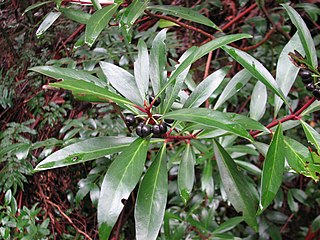
Tasmannia is a genus of woody, evergreen flowering plants of the family Winteraceae. The 40 species of Tasmannia are native to Australia, New Guinea, Sulawesi, Borneo, and the Philippines. The Winteraceae are magnoliids, and are associated with the humid Antarctic flora of the Southern Hemisphere. The members of the family generally have aromatic bark and leaves, and some are used to extract essential oils. The peppery-flavored fruits and leaves of this genus are increasingly used as a condiment in Australia. The peppery flavour can be attributed to polygodial.

Eidothea is a genus of two species of rainforest trees in New South Wales and Queensland, in eastern Australia, constituting part of the plant family Proteaceae. The plant family Proteaceae was named after the shape-shifting god Proteus of Greek mythology. The genus name Eidothea refers to one of the three daughters of Proteus.

Howittia is a genus of plant containing the single species, Howittia trilocularis, commonly known as blue howittia, and is endemic to Australia. It is a tall shrub found growing in shaded valleys and on rainforest edges, it has hairy leaves and single, purple flowers.
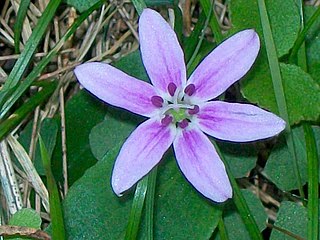
Schelhammera is a genus of perennial flowering plants in the family Colchicaceae, comprising two species.
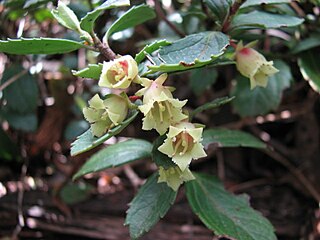
Wittsteinia vacciniacea , the Baw Baw berry, is a shrub species in the family Alseuosmiaceae. It is endemic to Victoria, Australia. It grows to about 40 cm high and has leaves which are between 1 and 5 cm long. The fragrant flowers are between 4.5 and 7 mm long and are followed by greenish-white rounded fruits.

Podolobium alpestre, commonly known as alpine shaggy-pea, is a flowering plant in the family Fabaceae and is endemic to south-eastern Australia. It has oblong to egg-shaped leaves and yellow to orange pea-like flowers with red markings.
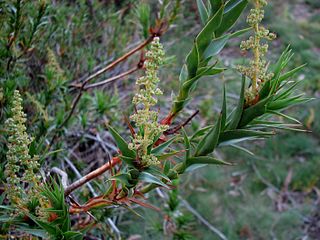
Richea victoriana is a species of flowering plant in the family Ericaceae that is endemic to Victoria, Australia. It is similar to Richea continentis, with differences including the presence of prominent leaf scars on the stems and inflorescences that are less than 12 cm long and have a hairless stem. The species was first formally described in 1995 in Muelleria based on plant material collected from the Thomson River headwaters. It occurs in wet areas in the vicinity of the Baw Baw plateau and the Blue Range.
Trochocarpa clarkei, commonly known as lilac berry, is a rare flowering plant in the family Ericaceae. It is endemic to sub-alpine areas of Victoria in Australia. It is a shrub which grows to around 30 cm high. The flowers are maroon with a greenish base. The fruits, which appear in autumn, are about 8 mm in diameter. These are eaten by small mammals and birds. The species occurs in subalpine areas of the southern highlands, often in association with Eucalyptus pauciflora.
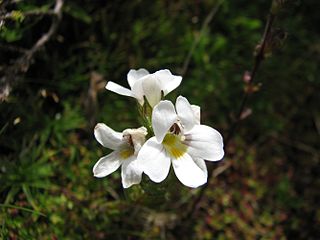
Euphrasia gibbsiae is a perennial herbaceous plant in the genus Euphrasia. It is native to Victoria and Tasmania in Australia. Species in this genus may be called eyebright.

Veronica nivea, the milfoil speedwell or snow speedwell, is a flowering plant species of the family Plantaginaceae, endemic to south-eastern Australia. It is sometimes included in the genus Parahebe or Derwentia.
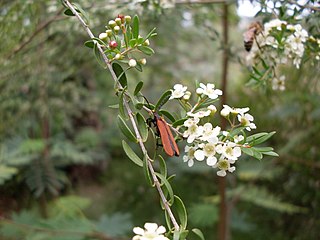
Sannantha pluriflora, commonly known as tall baeckea, is a flowering shrub or small tree species in the myrtle family, Myrtaceae. It is endemic to Australia. Plants grow to 4 metres high. White flowers appear in groups of three to seven between October and April in the species' native range. These have five rounded petals surrounding 8–15 stamens. The fruits are 2.5 to 3.5 mm in diameter.

Podolobium procumbens, commonly known as trailing shaggy-pea, trailing podolobium or trailing oxylobium, is a flowering plant in the family Fabaceae and is endemic to south-eastern Australia. It is a trailing small shrub with oval-shaped leaves and orange pea-like flowers.
Eremophila crassifolia, commonly known as thick-leaved emubush or trim emubush, is a flowering plant in the figwort family, Scrophulariaceae and is endemic to an area extending from New South Wales through Victoria to southern parts of South Australia. It is a low, spreading shrub with clustered leaves and bell-shaped, usually mauve-coloured flowers.

Correa lawrenceana var. latrobeana is a variety of Correa lawrenceana that is endemic to south-eastern Australia. It is a shrub or small tree with elliptical to egg-shaped leaves and cylindrical, greenish-yellow or reddish-mauve flowers arranged singly or in groups of up to seven in leaf axils or on the ends of branchlets.

Coprosma moorei, commonly known as blue matcurrant or turquoise coprosma, is a small, mat forming, prostrate shrub in the Rubiaceae family. It is native to highland areas of Tasmania and Eastern Victoria.
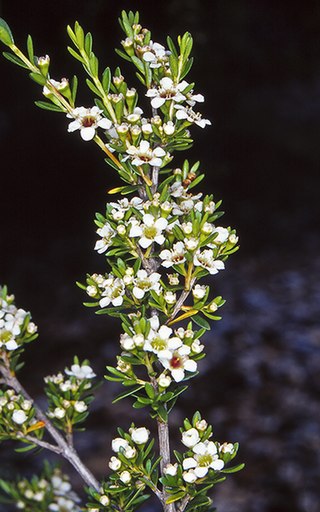
Baeckea latifolia is a species of flowering plant in the family Myrtaceae and is endemic to south-eastern continental Australia. It is a shrub with broadly elliptic leaves and small white flowers with six to eight stamens.
















